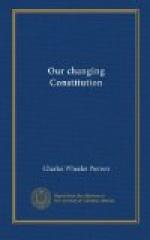[Footnote 1: Revenue Act of 1918, Title XII.]
There was no pretense that this act was enacted for the purpose of raising revenue. The revenue feature was merely legislative camouflage. To quote the words of Justice Holmes in a recent case,[1] “Congress gave it the appearance of a taxing measure in order to give it a coating of constitutionality.”
[Footnote 1: United States v. Jin Fuey Moy, 241 U.S., 394.]
The debate in the Senate was highly illuminating.[1] Its sponsors admitted that the measure was not expected or intended to produce revenue but was designed to regulate child labor and nullify the decision of the Supreme Court. Senators learned in the law conceded that if this purpose and effect were declared on the face of the act, or were necessarily inferable from its provisions, it must inevitably be declared unconstitutional. Reliance was placed, however, on the facts that the act was entitled “A bill to raise revenue,” and that its provisions did not necessarily, on their face, belie this label. It was argued that the Supreme Court would be bound, under its own previous rulings, to treat the act as if it were what it purported on its face to be—a revenue measure—and to ignore common knowledge and senatorial admissions to the contrary. The measure passed the Senate by a substantial majority and was enacted as part of the revenue bill then under consideration, from which it has been carried forward into the present revenue law.
[Footnote 1: See “Congressional Record” of December 18, 1918.]
There the matter stands at this writing. A District Court judge has declared the new act unconstitutional but the question has not yet been passed upon by the Supreme Court.
It would be venturesome to attempt to predict what the Supreme Court will do about it. Many constitutional lawyers seem to think that Congress has succeeded in its attempt and that the act will be sustained. Certainly there are strong precedents pointing that way. Three in particular will be relied upon—the Veazie Bank case, the Oleomargarine case and the Narcotic Drug Act case.
In the Veazie Bank case[1] the Supreme Court upheld the validity of a so-called tax law whose purpose and effect were to suppress the circulation of notes of the state banks. In the Oleomargarine case[2] the Court upheld a tax whose purpose and effect were to suppress the manufacture and sale of oleomargarine artificially colored to look like butter. In the Narcotic Drug case[3] the Court upheld a tax imposed by the so-called Harrison Act[4] whose purpose was to regulate the sale and use of narcotic drugs. In each of these cases there could be no doubt in the mind of any intelligent man as to the motive for the enactment. The Court has uniformly maintained, however, that




